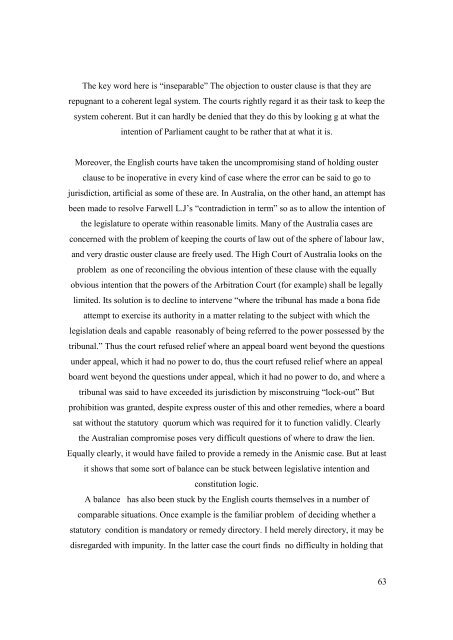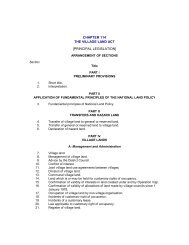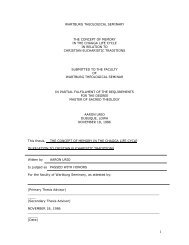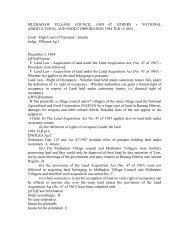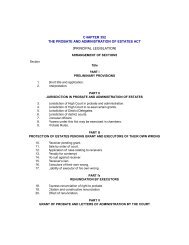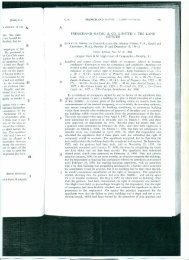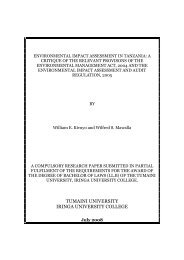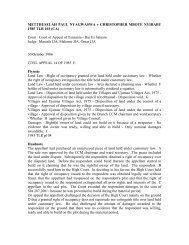- Page 1 and 2:
A COMPILATION OF CASES OF JUDICIAL
- Page 3 and 4:
4.3 Assistant Imports controller v
- Page 6 and 7:
appropriate respondent, i.e, if in
- Page 8 and 9:
the individual complaining of breac
- Page 10 and 11:
of the Constitution that there shou
- Page 12 and 13: y one judge of the High Court. Desp
- Page 14: Question(1) Their Lordship can deal
- Page 17 and 18: ights and freedoms to satisfy the r
- Page 19 and 20: The contravention was in the past;
- Page 21 and 22: is entitled. The respondent must pa
- Page 23 and 24: independence, as the result of nego
- Page 25 and 26: emedy, but only by consent of the C
- Page 27 and 28: policy justifies these distinctions
- Page 29 and 30: compulsorily on payment of .compens
- Page 31 and 32: have already touched on this. I do
- Page 33 and 34: ‘s favour would have been a right
- Page 35 and 36: in cases of judicial misbehavior, a
- Page 37 and 38: of course, is not in the ordinary s
- Page 39 and 40: of these provisions is to ensure th
- Page 41 and 42: which he appealed by special leave.
- Page 43 and 44: does not exclude the application of
- Page 45 and 46: “………no person should be pun
- Page 47 and 48: state. By section 19 (2) of the Cro
- Page 49 and 50: tot for anything done by Maharaj J.
- Page 51 and 52: of this section ;and (b)to determin
- Page 53 and 54: this was a finding that the judge,
- Page 55 and 56: February 27. The judgment of the ma
- Page 57 and 58: It was a state act performed by the
- Page 59 and 60: A defendant is always entitled to k
- Page 61: to come before the House of Lord’
- Page 65 and 66: Assuming that “commonwealth” wa
- Page 67 and 68: the High Court within a limited tim
- Page 69 and 70: Ouster clauses which take effect on
- Page 71 and 72: jurisdiction if they are disputed b
- Page 73 and 74: eviction by NAFCO. The special and
- Page 75 and 76: separation of powers enshrined in t
- Page 77 and 78: 2. that the Honorable trial judge e
- Page 79 and 80: section 2 of land ordinance, 1922 i
- Page 81 and 82: statutorily on trust for the benefi
- Page 83 and 84: such consent is required only in ca
- Page 85 and 86: language of that section precludes
- Page 87 and 88: There is merit in this ground of ap
- Page 89 and 90: section 4 and would undoubtedly hav
- Page 91 and 92: Clearly this section in unconstitut
- Page 93 and 94: ional crystallization, of the idea
- Page 95 and 96: That, the exparte application for t
- Page 97 and 98: espect, after all is said, and writ
- Page 99 and 100: to BAWATA’s Secretary General who
- Page 101 and 102: From the above persuasive cases, I
- Page 103 and 104: opinion, that where the Court used
- Page 105 and 106: JudgeCourt: Now case to be referred
- Page 107 and 108: the charge had already been entered
- Page 109 and 110: was violative of her basic right as
- Page 111 and 112: in that court, and in the course of
- Page 113 and 114:
In the result the appeal by the Dir
- Page 115 and 116:
that the proceedings before the Tri
- Page 117 and 118:
Prof. Shivji urged that when the ma
- Page 119 and 120:
Administered by inferior tribunals
- Page 121 and 122:
was found to be a nullity for irrat
- Page 123 and 124:
Those who espouse the narrow approa
- Page 125 and 126:
31. (1985) At p. 3532. One of the p
- Page 127 and 128:
Application on merits. Mandamus iss
- Page 129 and 130:
Those who exist above the people mu
- Page 131 and 132:
November 1986 they made a market su
- Page 133 and 134:
In the case at hand of course the a
- Page 135 and 136:
of each case, but it a fundamental
- Page 137 and 138:
I note that in the Advisory Committ
- Page 139 and 140:
The complaint is not that a person
- Page 141 and 142:
The applicants. Who were bidding in
- Page 143 and 144:
A paradigm,but not the only case of
- Page 145 and 146:
claims not to contain legal rules,
- Page 147 and 148:
743. All these cases show that it i
- Page 149 and 150:
as conclusive of the absence of a c
- Page 151 and 152:
The code is therefore framed in non
- Page 153 and 154:
“In my view to allow English citi
- Page 155 and 156:
eceive a further ⅔ per cent based
- Page 157 and 158:
alternative and that, reading the u
- Page 159 and 160:
On the morning of 25 November 1986
- Page 161 and 162:
The issue is thus whether the histo
- Page 163 and 164:
The Criminal Injuries Compensation
- Page 165 and 166:
part of decision - makers and for b
- Page 167 and 168:
Nothing that I have said can fetter
- Page 169 and 170:
underestimating the extent tot whic
- Page 171 and 172:
egulation” may be misleading. The
- Page 173 and 174:
More recently, in Reg. v. British B
- Page 175 and 176:
NICHOLLS L.J. I entirely agree with
- Page 177 and 178:
The code also contains some detaile
- Page 179 and 180:
appellant was tried on a count char
- Page 181 and 182:
founder parties should have used th
- Page 183 and 184:
(4) Since the case is based on aver
- Page 185 and 186:
Thus we held that any member of the
- Page 187 and 188:
procedure prescribed by Order 1, ru
- Page 189 and 190:
It is settled in our constitutional
- Page 191 and 192:
of judicial innovation to say that
- Page 193 and 194:
It follows from the foregoing that
- Page 195 and 196:
will not succeed. The court cannot
- Page 197 and 198:
The petition originally raised very
- Page 199 and 200:
disclosed in that context. He maint
- Page 201 and 202:
of the legislation and that there i
- Page 203 and 204:
…the restriction imposed at commo
- Page 205 and 206:
This provision, in my view, caters
- Page 207 and 208:
I agree and can not wish to add any
- Page 209 and 210:
It is contended by the petitioner t
- Page 211 and 212:
It extends to modification of those
- Page 213 and 214:
These amendments were, therefore, v
- Page 215 and 216:
courts in respect of the stay of su
- Page 217 and 218:
namely, an assembly or procession n
- Page 219 and 220:
of law and order. I provision like
- Page 221 and 222:
Until the Legislature makes appropr
- Page 223 and 224:
his representatives; the right to r
- Page 225 and 226:
in the Constitution? In that case t
- Page 227 and 228:
to appoint persons to offices in th
- Page 229 and 230:
I hereby certify that this is a tru
- Page 231 and 232:
It is sworn further that in the cou
- Page 233 and 234:
applicants. And if I may say now, a
- Page 235 and 236:
A part from the applicants obligati
- Page 237 and 238:
It seems that this issue once decid
- Page 239 and 240:
Finally, Mr. Werema made an alterna
- Page 241 and 242:
to find a case which shows there is
- Page 243 and 244:
Delivered.Dr. Lamwai for the Applic
- Page 245 and 246:
However, he pointed out that it is
- Page 247 and 248:
IN THE COURT OF APPEAL OF TANZANIAA
- Page 249 and 250:
anything, he was simply answering w
- Page 251 and 252:
appellants the opportunities of bei
- Page 253 and 254:
For these reasons we are satisfied
- Page 255 and 256:
jurisdiction to go wrong. Neither a
- Page 257 and 258:
Essentially these grounds are alleg
- Page 259 and 260:
in agreement. However, the advocate
- Page 261 and 262:
Attorney General was duly summoned,
- Page 263 and 264:
Once we hold as indeed we do, that
- Page 265 and 266:
surfaced from the very beginning. I
- Page 267 and 268:
of Dodoma Zone Mr. Mwambe duly inst
- Page 269 and 270:
26 Act No. 16 of 198427 Chapter 360
- Page 271 and 272:
the case of Attorney-General v. Les
- Page 273 and 274:
1991on the Democratic system in Tan
- Page 275 and 276:
efusal in short the decisions were
- Page 277 and 278:
public interest should not be too b
- Page 279 and 280:
operation was “thoroughly outdate
- Page 281 and 282:
In the final analysis, I find that
- Page 283 and 284:
J. dated the 24 th day of October,
- Page 285 and 286:
though we felt that the learned Sta
- Page 287 and 288:
(a). that every persons shall, when
- Page 289 and 290:
The more difficult question is whet
- Page 291 and 292:
Turning now to the requirement that
- Page 293 and 294:
The appeal is allowed with cast, an
- Page 295 and 296:
6. Tanzania Air service ltd v minis
- Page 297 and 298:
A company (Cyanamid) register a pat
- Page 299 and 300:
506 All England Law Reports (1975)
- Page 301 and 302:
a. patents in 1953 (Lowe) and 1954
- Page 303 and 304:
efore any question of balance of co
- Page 305 and 306:
object that I have indicated above
- Page 307 and 308:
this. Returning therefore to the in
- Page 309 and 310:
MAGNUM AGENCLES COMPANY LIMITED RES
- Page 311 and 312:
Without going into his locals stand
- Page 313 and 314:
BANK OF TANZANIA MWANZABut the prop
- Page 315 and 316:
Similarly the present record does n
- Page 317 and 318:
78 TANZANIA LAW REPORTS (1987) T.L.
- Page 319 and 320:
Maina ,J This is an application to
- Page 321 and 322:
e made informally. But with respect
- Page 323 and 324:
82 TANZANIA LAW REPORTS (1987)T.L.R
- Page 325 and 326:
Temeke, Dar es salaam, delivered in
- Page 327 and 328:
3. that the reference was in any ev
- Page 329 and 330:
2. that the application has no righ
- Page 331 and 332:
c.c.s.u v, minste for civil service
- Page 333 and 334:
communications headquarters (GCHQ)
- Page 335 and 336:
)2) of the European Convention on H
- Page 337 and 338:
dismiss persons refusing to accept
- Page 339 and 340:
matters relating to the dispassion
- Page 341 and 342:
extending he requirement of natural
- Page 343 and 344:
continue to be enjoyed although mig
- Page 345 and 346:
the grounds upon which administrati
- Page 347 and 348:
alter right or obligations enforcea
- Page 349 and 350:
I agree with your Lordships tat thi
- Page 351 and 352:
the appellants employment be termin
- Page 353 and 354:
The trial judge dismissed appellant
- Page 355 and 356:
the view that the appellant’s ter
- Page 357 and 358:
Court did not stop there. It consid
- Page 359 and 360:
In English I have been instructed t
- Page 361 and 362:
the respondents such order was gran
- Page 363 and 364:
to response to the .. of an appell
- Page 365 and 366:
Was Annex D.1 made in bad faith? Th
- Page 367 and 368:
when questioning the constitutional
- Page 369 and 370:
24 th May 1991 informing the appell
- Page 371 and 372:
We are therefore of the opinion tha
- Page 373 and 374:
him of that decision is in our view
- Page 375 and 376:
usurp the function of the High Cour
- Page 377 and 378:
MAUGHAM in maritime Elective C. Ltd
- Page 379 and 380:
We again agree with the learned jud
- Page 381 and 382:
However, the learned judge skipped
- Page 383 and 384:
filing of statements could not be s
- Page 385 and 386:
even to seem to express an opinion
- Page 387 and 388:
As we have already intimated the te
- Page 389 and 390:
the removal. But we reject the earl
- Page 391 and 392:
the Daily News and Uhuru newspapers
- Page 393 and 394:
M.D. BOMANIAg. JUSTICE OF APPEALJ.L
- Page 395 and 396:
Both parties are represented by cou
- Page 397 and 398:
THE SECUTITY FO EMPLOYMENT ACT 1964
- Page 399 and 400:
administrative law as seriously as
- Page 401 and 402:
interest are at stake. In any other
- Page 403 and 404:
the fundamentals of good administra
- Page 405 and 406:
mandamus should be made but it must
- Page 407 and 408:
6. EXERCISE OF DISCRETIONARY POWERS
- Page 409 and 410:
Mr. Mselem was at a loss to know un
- Page 411 and 412:
under s. 3 (3) of Cap. 104 and none
- Page 413 and 414:
affidavit and the representations o
- Page 415 and 416:
17 th June 1987 requiring him to le
- Page 417 and 418:
SongeaMohamed Ally Athumani now 54
- Page 419 and 420:
Ally Athumani PW1 had received. He
- Page 421 and 422:
Home is cases of ones in search of
- Page 423 and 424:
nothing about the subject matter as
- Page 425 and 426:
commissioner of Songea District was
- Page 427 and 428:
in all details to the one issued to
- Page 429 and 430:
approved by village Governments. DW
- Page 431 and 432:
forces that are always inconsistent
- Page 433 and 434:
under the Business licincing Act No
- Page 435 and 436:
applicants these could definitely n
- Page 437 and 438:
person against who he intends issue
- Page 439 and 440:
dealings. Expedient is not this Rep
- Page 441 and 442:
espondent to discharge its function
- Page 443 and 444:
(i) an order of certiorari 8 and se
- Page 445 and 446:
Mr. Mwaikusa argued that the releva
- Page 447 and 448:
that the Government has set on itse
- Page 449 and 450:
AT DODOMACIVIL CASE NO. 23 OF 1993J
- Page 451 and 452:
for Tabora Region . By a letter dat
- Page 453 and 454:
of the Constitution or the law of t
- Page 455 and 456:
Another important consideration und
- Page 457 and 458:
have been taken into account, wheth
- Page 459 and 460:
withstanding the existence of an ou
- Page 461 and 462:
arbitrary decision. And it offends
- Page 463 and 464:
to the Principal Secretary to the P
- Page 465 and 466:
I heard long and interesting arqume
- Page 467 and 468:
public interest; second, it is the
- Page 469 and 470:
the former the Principal Secretary
- Page 471 and 472:
I think I can dispose of this matte
- Page 473 and 474:
the whole field of the law relating
- Page 475 and 476:
declaration except in a negative so
- Page 477 and 478:
itom 108(1) of the First schedule t
- Page 479 and 480:
egards the commission’s report, t
- Page 481 and 482:
RULLINGSAMATTA, JK:This is an appli
- Page 483 and 484:
impugned decision. As expected, I w
- Page 485 and 486:
(g) on retirement in circumstances,
- Page 487 and 488:
etire otherwise than on disciplinar
- Page 489 and 490:
(c) for pupose of facilitating impr
- Page 491 and 492:
“Whatever pleases the emperor has
- Page 493 and 494:
decision has, I agree with Mr Nasso
- Page 495 and 496:
Before I part with this application
- Page 497 and 498:
7. REMEDIES1. Ajit Gordhan v Direct
- Page 499 and 500:
21. Simeon Manyaki v Executive Comm
- Page 501 and 502:
of which was annexed to the affidav
- Page 503 and 504:
The above position was enshrined in
- Page 505 and 506:
such as damages or on injunction. T
- Page 507 and 508:
Should the prayer then be granted i
- Page 509 and 510:
No cases referred to.Omar and Musta
- Page 511 and 512:
IN THE HIGH COURT OF TANZANIAAT DAR
- Page 513 and 514:
alleged circumstance, it is further
- Page 515 and 516:
Mr Mallaba has traced the history o
- Page 517 and 518:
Mr. Kisusi submits further that sin
- Page 519 and 520:
ANDESSO STANDARD TANZANIA LIMITED .
- Page 521 and 522:
proceed by way certiorari. He can f
- Page 523 and 524:
AT MWANZACORAM: OMAR, J.A. HNZAVAS,
- Page 525 and 526:
G.N. 41/92, the second respondent i
- Page 527 and 528:
ecause it violates Article 13 of th
- Page 529 and 530:
tenants, one enjoying legal protect
- Page 531 and 532:
the provisions of the Rent Restrict
- Page 533 and 534:
Lastly, in ground 5 the appellants
- Page 535 and 536:
R V Income Tax Special Purposes Cou
- Page 537 and 538:
had interfered with the administrat
- Page 539 and 540:
LORD TEMPLEMAN. Parliament makes th
- Page 541 and 542:
LORD GRIFEITHS. My Lords, I have ha
- Page 543 and 544:
Because of this, it is normally unn
- Page 545 and 546:
students at his school; that he was
- Page 547 and 548:
unnaturally took the view that the
- Page 549 and 550:
solicitor later at about 12.30 am v
- Page 551 and 552:
Mr Baker was arranged for 4 pm that
- Page 553 and 554:
counsel with whem a conference took
- Page 555 and 556:
easonably benevolent construction o
- Page 557 and 558:
Lord Donalsdson MR described Mr Bak
- Page 559 and 560:
was made without jurisdiction, then
- Page 561 and 562:
Court has been given . If the appli
- Page 563 and 564:
in the earlier case may have coused
- Page 565 and 566:
As the Sovereign cannot authorize w
- Page 567 and 568:
When dismissiong the action Romer I
- Page 569 and 570:
the Crown. (In this summary 1 put o
- Page 571 and 572:
emedy against theCrown was not conf
- Page 573 and 574:
easonable doubt as to the identity
- Page 575 and 576:
Section 23 (2) (2) refers to petiti
- Page 577 and 578:
Corwn in general, then s 21 (2) wou
- Page 579 and 580:
epresenting the Crown, the third th
- Page 581 and 582:
obtain an injunction (see also Merr
- Page 583 and 584:
A both because there would be an in
- Page 585 and 586:
It is interesting to note the comme
- Page 587 and 588:
prohivition or certiorari (b) the n
- Page 589 and 590:
proceedings as was available to you
- Page 591 and 592:
lack of jurisdiction to grant inter
- Page 593 and 594:
egarded as being open to challenge
- Page 595 and 596:
quite out of accord with practice,
- Page 597 and 598:
The validity of the injunction gran
- Page 599 and 600:
IN THE HIGH COURT OF TANZANIAAT SON
- Page 601 and 602:
October; 1993, the Regional Commiss
- Page 603 and 604:
statutory authority for doing so, t
- Page 605 and 606:
egulation 10 as read with S. 55 (1)
- Page 607 and 608:
(4) In such a case the tribunal, wh
- Page 609 and 610:
the penalty demands notwithstanding
- Page 611 and 612:
question I have posed and speaking
- Page 613 and 614:
first two prayers, to wit, orders o
- Page 615 and 616:
and illegally taking then away from
- Page 617 and 618:
I conceded that as wrong in view of
- Page 619 and 620:
unquestionability upon its decision
- Page 621 and 622:
deciding what the decision-maker sh
- Page 623 and 624:
ut the judges must observe the cons
- Page 625 and 626:
intended to furtmore national polic
- Page 627 and 628:
society. That observation applies t
- Page 629 and 630:
In the event, the prayer for a decl
- Page 631 and 632:
25 th January 1978. However on 5 th
- Page 633 and 634:
missing from the trial court record
- Page 635 and 636:
One of the conditions set out in th
- Page 637 and 638:
(a) that up to the 5 th February, 1
- Page 639 and 640:
With regard to this passage of the
- Page 641 and 642:
Patman Garments Industries Limited
- Page 643 and 644:
dishonoured, or if he had broken th
- Page 645 and 646:
Decree of the High Court and declar
- Page 647 and 648:
y the Institute during the 1983/84
- Page 649 and 650:
obdurate if not- thoroughly uncoope
- Page 651 and 652:
examination papers to NBAA for mode
- Page 653 and 654:
against him, so that he could effec
- Page 655 and 656:
maters as the leakage of examinatio
- Page 657 and 658:
Q. Can you tell us anything strange
- Page 659 and 660:
IN THE HIGH COURT OF TANZANIA\MAIN
- Page 661 and 662:
against a government minister or de
- Page 663 and 664:
injunctive relief is sought? Althou
- Page 665 and 666:
appears to have done, to hold that
- Page 667 and 668:
the applicant leave to apply review
- Page 669:
669


